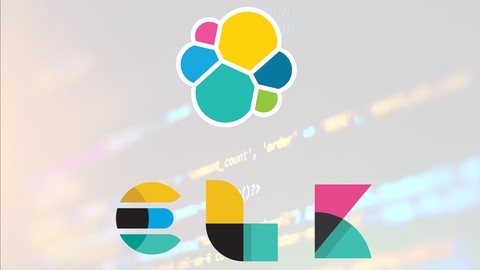Kibana is a powerful open-source data visualization and exploration tool that allows users to interact with their data in a meaningful way.
With Kibana, you can create interactive dashboards, charts, and maps to uncover hidden insights and patterns within your data, making it an essential tool for data analysts, engineers, and anyone working with large datasets.
Understanding Kibana can greatly enhance your ability to understand and communicate complex data effectively, leading to better decision-making and problem-solving.
Choosing the right Kibana course on Udemy can be a challenge, given the wide array of options available.
You’re likely looking for a course that’s well-structured, engaging, and taught by an instructor with practical experience.
The ideal course should provide a balance of theoretical knowledge and hands-on exercises, enabling you to confidently use Kibana in real-world scenarios.
After carefully reviewing numerous Udemy courses, we’ve identified the Complete Elasticsearch Masterclass with Logstash and Kibana as the best overall course for mastering Kibana.
This comprehensive masterclass provides a deep dive into Kibana, covering everything from basic concepts to advanced techniques, and also includes practical examples and projects to solidify your understanding.
It’s a fantastic resource for anyone looking to become proficient in Kibana.
However, this is just one of the many excellent Kibana courses available on Udemy.
To help you find the perfect fit for your learning style and goals, we’ve compiled a list of other top-rated courses.
Keep reading to discover more options, each catering to different skill levels and specific areas of interest within Kibana.
Complete Elasticsearch Masterclass with Logstash and Kibana
The course starts by introducing you to Elasticsearch and Kibana, guiding you through the setup process.
You’ll learn about alternative installation methods and get access to dedicated teaching assistant support and an online community on Discord.
Next, you’ll dive into the core concepts of Elasticsearch.
You’ll understand how it manages documents and analyzers, indexing and retrieving data, the components that make up an index, and how requests are distributed across the cluster.
The course covers text analysis techniques for indexing and searching, allowing you to define the structure of your indexes effectively.
You’ll then explore the Search DSL (Domain Specific Language) for querying Elasticsearch.
The course walks you through query and filter contexts, enabling you to construct complex search queries.
Additionally, you’ll learn about aggregations, which let you analyze and summarize your data.
The real-world project integrates Logstash, a data processing pipeline, with Elasticsearch and Kibana.
You’ll download and configure Logstash, then use it to index Apache application logs and CSV file data into Elasticsearch.
This hands-on experience will teach you how to work with different data sources.
Kibana, the visualization and dashboarding tool, is covered in-depth.
You’ll create visualizations and dashboards to analyze and present your data effectively.
The course also covers architecting the Elastic Stack, a collection of tools including Elasticsearch, Kibana, Logstash, and Beats like Filebeat.
You’ll learn how to set up Filebeat for shipping log data and use it with Logstash to index data into Elasticsearch.
Data Visualization with Kibana
This course equips you with the skills to visualize and analyze data effectively using Kibana.
You’ll start by setting up Kibana on your preferred operating system - macOS, Linux, or Windows - and explore Elastic Cloud for easier management.
You’ll also learn to use the Console tool for tasks like creating index templates and importing test data.
The course then guides you through the Discover app, where you’ll master the Kibana Query Language (KQL) to filter and analyze data.
You’ll learn how to create data views (formerly index patterns) and transform them into powerful visualizations such as area charts, line charts, heat maps, and tag clouds.
You’ll discover how to customize these visualizations with features like dynamic ranges (histograms) for in-depth analysis.
You will then move on to dashboards, learning how to create interactive dashboards that combine different visualizations, link visualizations to saved searches for quick insights, and even apply saved queries to visualizations for greater control over data analysis.
Finally, the course covers essential security features.
You’ll learn about spaces, users, roles, and privileges, gaining the ability to create and manage users, configure roles, and secure your Kibana environment.
ElasticSearch, LogStash, Kibana ELK #3 - Learn Kibana
The course starts by welcoming you and providing an introduction to becoming an online instructor, setting the stage for the learning journey ahead.
You’ll get an overview of the ELK stack, which includes Elasticsearch, Logstash, and Kibana.
This prepares you for the main focus of the course: Kibana.
The course dives deep into Kibana, covering its installation, configuration, and the three pillars that form its foundation.
One of the key aspects you’ll learn is the “Discover” feature of Kibana, which allows you to explore and analyze your data.
The course dedicates multiple lectures to this, ensuring you have a solid understanding of this crucial functionality.
Moving on, you’ll delve into the powerful visualization capabilities of Kibana.
The course covers various types of visualizations, including area charts, data tables, line charts, markdown visualizations, pie charts, tilemaps, and bar charts.
You’ll learn how to create and customize these visualizations, enabling you to present your data in a visually appealing and insightful manner.
The course also introduces you to aggregations, which are essential for summarizing and analyzing your data within Kibana.
This knowledge will empower you to extract valuable insights from your datasets.
Another key aspect covered is Kibana dashboards, which allow you to combine multiple visualizations and data sources into a single, cohesive view.
You’ll learn how to create and customize dashboards, making it easier to share and present your findings.
Extending Kibana’s functionality is also covered, with lectures dedicated to plugins.
You’ll explore plugins like tagcloud, heatmap, and slider, enabling you to enhance Kibana’s capabilities and tailor it to your specific needs.
The course also touches on Kibana settings, tips, and tricks, ensuring you have a well-rounded understanding of the tool and can optimize its performance and usability.
Throughout the course, you’ll find “Test your knowledge” sections, which allow you to reinforce your learning and assess your understanding of the material covered.
ELASTIC 8: Monitoring with Elasticsearch, Kibana, Beats, APM
You’ll start with an introduction to the tooling required and decide whether to use Elastic Cloud or an on-premise setup.
From there, you’ll learn how to design and set up an Elasticsearch cluster, both in Docker and on a Linux virtual machine using VirtualBox and Ubuntu.
The course guides you through configuring Elasticsearch and Kibana, including aspects like SSL certificates, node types, and config paths.
One of the key strengths of this course is its focus on integrating Beats for data ingestion.
You’ll learn how to set up Metricbeat, Filebeat, and Heartbeat, as well as how to create dashboards for monitoring their data.
Additionally, the course covers Elastic APM, teaching you how to configure the APM server and connect your applications for tracing.
The Kibana UI is explored in-depth, covering features like Discover, Visualizations, Dashboards, and Observability for logs, metrics, APM, and uptime monitoring.
You’ll also learn about stack management, user management, spaces, and license management within Kibana.
Alerting is another important topic covered, with guidance on setting up Kibana alerts and creating cases (using JIRA as an example).
Finally, you’ll learn how to upgrade your Elastic cluster, both in Docker and following the official documentation.
Throughout the course, you’ll have access to official Elastic documentation, configuration examples, and troubleshooting tips.
Kibana Masterclass - Capture, Analyze and Visualize Data
This Kibana Masterclass doesn’t waste any time getting you up to speed.
You’ll dive right into the ELK Stack—that’s Elasticsearch, Logstash, and Kibana—and learn how these powerful tools work together.
Don’t worry if you’re new to this; the course walks you through installing Kibana using Docker, a popular platform that makes setting up software a breeze.
You’ll even explore Kibana Cloud, giving you a taste of cloud-based data analysis.
You’ll master Kibana Analytics, starting with the Discover menu.
This is where you’ll learn to explore your data and uncover insights using KQL, Kibana’s very own query language.
The course then guides you through creating stunning visualizations, using a variety of charts, maps, and graphs to bring your data to life.
You’ll learn how to build dashboards that tell a story, allowing you to communicate your findings with clarity and impact.
Get ready to explore Kibana Observability, where you’ll learn how to keep a watchful eye on your applications’ performance.
You’ll discover the power of APM (Application Performance Monitoring) and use Kibana to track errors, identify bottlenecks, and set up alerts to stay ahead of any issues.
You’ll also dive into RUM (Real User Monitoring), gaining insights into how users experience your website and identifying areas for improvement.
And there’s more!
You’ll explore Kibana Enterprise Search, where you’ll learn to create powerful, custom search experiences for your applications using App Search.
Imagine being able to crawl websites, fine-tune search relevance, and even build your own search interfaces—that’s the power you’ll wield.
Complete Guide to Data Visualization with Kibana 8
This course guides you through setting up your environment, whether you prefer Windows, Mac, or Linux.
You’ll install Elasticsearch and Kibana, then dive into Elasticsearch’s architecture, understanding its terms, structure, and field types.
You’ll even test your knowledge with quizzes.
The course then shows you how to use Dev Tools to add sample data, either through the “Try sample data” feature or by integrating data from machine learning.
You’ll learn how to analyze this data with Discover, exploring logs, analyzing statistics, filtering documents, and even saving data to CSV files.
With a solid understanding of your data, you’ll move on to creating visualizations with Kibana.
You’ll learn to build a wide array of visualizations like Area, Line, Data Table, Heat Map, Metric, Horizontal Bar, Pie, Vertical Bar, Lens, and Text visualizations, using Input Controls to make them interactive.
You’ll also create maps, such as Cluster Maps, directly within Kibana.
The course then teaches you how to bring your visualizations together by creating interactive Dashboards.
You’ll learn to add text, controls, graphs, and filters to your dashboards, gaining valuable insights from your data.
You’ll even discover how to save data directly from your graphs.
Finally, you’ll delve into Kibana Management, exploring Stack Management, Spaces, and how to manage users and roles to ensure data security and efficient organization.
This course goes beyond simply listing features, providing a clear path from beginner to creating compelling visualizations and managing your Kibana environment.
You’ll not only learn how to use various tools and features, but also understand when and why to use them.
Kibana and Elasticsearch: Data Analysis and Visualization
This Kibana and Elasticsearch course takes a practical, project-based approach to teach you the ins and outs of data analysis and visualization.
You’ll work on three real-world projects, starting with analyzing employee browsing interests.
You’ll learn how to load and analyze data in Elasticsearch, then use Kibana to create visualizations like charts and graphs, and finally, build interactive dashboards to present your findings.
The course then dives into supermarket sales analysis, teaching you how to uncover trends and patterns in customer behavior.
You’ll learn techniques for uploading, visualizing, and analyzing sales data.
You’ll also build dashboards to track key metrics, helping you understand what’s driving sales and identify areas for improvement.
The final project focuses on metric monitoring and tracking using Metricbeat, a tool for gathering data from various sources.
You’ll also gain a solid foundation in Elasticsearch itself, going beyond just using Kibana.
You’ll learn about important concepts like mappings, which define how data is structured in Elasticsearch, and analyzers, which help you break down text for better search results.
You’ll explore different query types, allowing you to retrieve specific data from Elasticsearch.
You’ll even learn how to translate SQL queries, commonly used for relational databases, into Elasticsearch queries.
The course introduces you to the ELK Stack – a powerful combination of Elasticsearch, Logstash (for data processing), and Kibana.
You’ll explore NoSQL databases and learn how to install and configure Elasticsearch.
You’ll learn how to use Python, a popular programming language, to automate tasks and interact with Elasticsearch more efficiently.
You’ll dive into advanced Elasticsearch features like custom analyzers, which allow you to tailor text analysis to your specific needs, and dynamic templates, which make it easier to handle different data types.
You’ll even explore Elasticsearch APIs, which let you manage and interact with your Elasticsearch cluster programmatically.
Kibana Projects: Mastering Analytics and Visualization
This Kibana course will teach you how to analyze data and create visualizations like a pro.
You will learn by working on three real-world projects.
In the first project, you will analyze employee browsing interests.
You will learn how to load data into Elasticsearch and then use Kibana to analyze it.
You will create visualizations like charts and graphs and build a dashboard to present your findings.
Next, you will learn how to monitor metrics and track data.
You will use Metric beat to collect data and then visualize it in Kibana.
You will also learn the basics of Python programming and how to use it with Kibana.
This will allow you to automate tasks and make your work more efficient.
Finally, you will put all your skills to the test by analyzing supermarket sales data.
You will learn how to upload data into Kibana, create visualizations to understand sales trends, and build a dashboard to present your findings.








